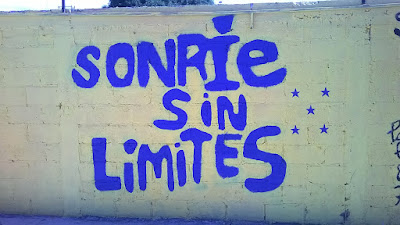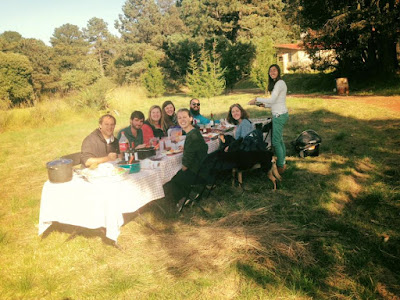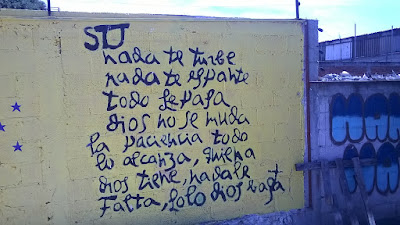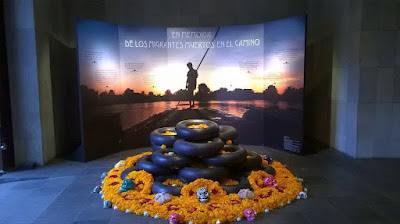Dear friends,
Holiday greetings from CDMX! I hope you are all enjoying the winter weather, whether that be cold and snowy or otherwise, and the holiday preparations. Although Mexico City is anything but cold and wintery (highs are generally in the mid-70s lows in the mid-40s), the city is embracing the holiday spirit, with Christmas lights, ice-skating rinks, artificial snow, and even a fake hill in the city center for kids to sled down. I have been busy getting ready for holiday celebrations with my host community-for my church´s Christmas posada (a re-enactment of the Christmas story) and my office's Christmas party, where your's truly will be performing with the office band, Los Ecumenical All Stars. As much as I have enjoyed getting ready for the holidays, I have been hit with occasional pangs of homesickness, knowing that this is my first holiday season away from home. However, I wanted to share an experience from our first YAGM group retreat that impacted me strongly, and and threw my experience of being away from home during the holidays into a whole new perspective.
One of the many strengths of the YAGM program is that it intentionally works to build community, not only within our host communities, but also within the group of volunteers. YAGM volunteers regroup three times during the year for week-long retreats in order to rest, bond as a group, and share our experiences. This November, I spent Thanksgiving week with the other YAGM-Mexico volunteers and our country coordinators in the gorgeous state of Tlaxcala. After a few months in the city, it was wonderful to get out into the mountains, breath fresh air, and be outside of the traffic and congestion for a few days.
Some of the lovely Tlaxcala landscape.
Although I was excited to spend Thanksgiving with the other volunteers and our country coordinators, I felt pangs of homesickness in thinking of my family back at home. Thanksgiving in my family is a borderline sacred affair, with a spread of food of Southern Living magazine proportions. As a southerner, I associate Thanksgiving with fried turkey, cornbread and oyster stuffing, sweet potato soufflé, collard greens, and two types of cranberry sauce (one fresh, and the other that still has indentations from the can). Mostly though, I associate Thanksgiving with a lot of love and laughter, surrounded by a huge family.
I was thinking of memories of past Thanksgivings when on the day before Thanksgiving we went as a group to visit the migrant shelter La Sagrada Familia, in Apizaco, Tlaxcala. Our theme for our week-long retreat was globalization and economics, and we spent significant time discussing the impact of economic decisions and trade agreements (such as NAFTA) on the Mexican/Latin American economy and migration. As part of this discussion, we went to visit La Sagrada Familia, where YAGM volunteers have served in the past, and where one of our volunteers has just begun to serve this year. This shelter opened in 2010 and since then, has served about 30,000 guests, most of whom stay for 1-2 nights. 90% of the guests are 25-35 year old men, although they have received boys as young as 14 who are traveling alone, and women who have given birth in the shelter during their journeys (sound familiar?). Most are from El Salvador, Guatemala, Nicaragua, and Honduras, and are traveling north-either to the US, or to other locations in Mexico. Many are seeking greater economic opportunity, or are escaping violence-during our visit, we met an 18-year old man from Honduras whose 4 brothers were murdered by gangs, before his mom begged him to go the US for his own safety.
The shelter entrance.
Mural at the shelter-¨Smile without limits.¨
The majority of migrants arrive to the shelter on the infamous La Bestia (the beast), referring to the system of trains that many migrants ride north. These trains are also known as ¨trains of death¨-by the time many migrants arrive to the shelter in Apizaco, they have been traveling for 15-20 days. They ride on the top of the train, although they sometimes have to cling to the side for 15-20 hours at a time. Almost all are assaulted, beaten, or robbed during their journey, and train company employees are known to shoot at the migrants as they pass by. Many women and girls are victims of rape and sexual violence during their journey. As they reach Apizaco and the colder climates without sufficient winter clothing, many are at risk for frostbite, hypothermia, and illness. La Bestia passes right next to the shelter, and migrants have to leap off the moving train and avoid the cement poles that line both sides of the track. The train company erected these poles in order to deter migrants from riding the trains-however, there is a mere 50 cm. gap between the moving train car and the poles. Too frequently, when migrants try to jump down from the train car and avoid the poles, they are thrown under and crushed by the wheels. We were able to see this train pass during our visit, and although it was empty of passengers, I shuddered as I stood next to the tracks, heard the screech of the wheels, and saw the metal glow hot red as the cars lumbered north.
La Bestia passing by the shelter.
The narrow gap between the poles and the train.
One of the things that has surprised me during my time in Mexico is how many people have ties to North Carolina, and my experience at La Sagrada Familia was no different. We were able to speak with a group of migrants who were staying at the shelter, and when I mentioned that I was from North Carolina, one of the men replied that he had lived in NC for years, and had spent significant time in Raleigh, Charlotte, Asheville, Elizabeth City, and Wilson, where had worked in roofing for many years before being deported. His children, however, are US citizens and remain back in the US, awaiting him as he attempts another journey north. ¨I didn't go to the US to commit crimes or destroy the American dream-I don't drink, I don't smoke, I don't even drive over the speed limit,¨ he shared with the group. ¨I came to do the jobs that no one wants to do, that US citizens don't want to do-no one wants to work in roofing in NC in the summer! I just want to provide a better life for my family.¨
Map of routes to the US.
The group at La Sagrada Familia with our host Angel.
With our time wrapping up, we wished the men best of luck in their journey, and our country coordinator Omar shared a special wish for the migrants, several of whom were fellow honduerños. ¨Never be ashamed of making this journey or trying to provide a better life for your families. It is nothing to be ashamed of. And if you ever feel unsafe in your communities back home, don't be afraid to take care of yourself and leave.¨ As we headed back to start preparations for Thanksgiving, I thought of the irony of visiting a migrant shelter the day before the US celebrates the welcoming of European refugees by the local indigenous population. I thought of the 18 year old man clinging to the side of the train in the cold, while my 18 year old brother is able to focus on his studies and friends at one of the top universities in the country. I thought of the tiny blue book sitting back in my suitcase that will allow me to comfortably cross back over the border to a life that couldn't be farther removed from those of many of the men we met at the shelter.
The gang getting dinner ready.
And the following day, as I sat down to a table groaning with the weight of food, looking out over the mountains, surrounded by a newfound family, I gave thanks. Thanks for the overabundant food, while many who I had met the day before didn't know where their next meal would come from. Thanks for my family back in the US, who I will be able to see again in just a few weeks, while many in the US wait for their loved ones, not knowing if they will survive the journey. Thanks for my fellow volunteers and country coordinators, who have been a source of joy and support these four months. Thanks for my host community in CDMX who has welcomed me with open arms, and carried me through the highs and lows. And thanks for those back in the US working to improve a broken immigration system, working to be a country that continues to receive ¨...your tired, your poor, your huddled masses yearning to breath free...¨, regardless of skin color, income, nationality, language, religion, or anything else. A country that can work to fulfill the promise that so many risk life and limb hoping to find-life, liberty, and pursuit of happiness for all.
YAGM-Mexico fam.
Quote at the shelter from a popular hymn-one translation reads:
¨Let nothing disturb you,
let nothing frighten you,
everything passes,
but God stays.
Patience reaches all,
(s)he who has God,
lacks nothing:
God alone suffices.¨






































